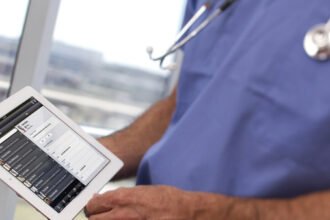 Creating and launching innovative ground-breaking new technologies and solutions is a heady experience, especially in health care where innovations can literally save lives. Pioneering new technology is hard and very expensive work. There is always a rush to get the product finished enough to be able to launch and start generating some revenue.
Creating and launching innovative ground-breaking new technologies and solutions is a heady experience, especially in health care where innovations can literally save lives. Pioneering new technology is hard and very expensive work. There is always a rush to get the product finished enough to be able to launch and start generating some revenue.
 Creating and launching innovative ground-breaking new technologies and solutions is a heady experience, especially in health care where innovations can literally save lives. Pioneering new technology is hard and very expensive work. There is always a rush to get the product finished enough to be able to launch and start generating some revenue. Features considered not essential are pushed farther out on the product roadmap and these products are launched based on the innovations that have been implemented.
Creating and launching innovative ground-breaking new technologies and solutions is a heady experience, especially in health care where innovations can literally save lives. Pioneering new technology is hard and very expensive work. There is always a rush to get the product finished enough to be able to launch and start generating some revenue. Features considered not essential are pushed farther out on the product roadmap and these products are launched based on the innovations that have been implemented.
A couple of products come to mind as examples: FlowSense Medical’s digital urine flow meter (recently acquired by Baxter) and PixCell Medical’s cell based point of care diagnostics. In both of these cases, a non essential capability that’s been pushed off is connectivity. Feature trade-off decisions is an everyday activity in medical device product development. However, every trade-off has consequences. Let’s look at those consequences, and more importantly, how to mitigate them.
One of the best conceptual frameworks for launching and growing new technology and products in health care is Geoffrey Moore’s Crossing the Chasm. Moore’s framework divides a new product’s market opportunity between innovators and early adopters on one side, and early/late majority and market laggards on the other. In between these two groups is the chasm where a shift in market requirements can hold up – or completely stall – market adoption of your new product.
Moore determined that innovators and early adopters (who make up about 16% of a potential market) will buy innovative new technologies that work but are not as “full featured” as a mature product. These buyers are willing to put up with inconveniences or what they see as “minor” shortcomings of a newly launched product to be among the first to take advantage of the new capabilities of this innovation. The remaining 84% of the market, containing the early and late majority and market laggards, have different expectations for the products they purchase. This majority of the market wants proven full-featured products they can buy with confidence that will work with little or no fuss on the part of the hospital.
This difference in market requirements, raw innovation on one side and a mature easy to buy, implement and use solution on the other, is what Moore calls the chasm. It’s a chasm because early majority buyers will not buy the product that innovators and early adopters were happy to buy. And once you’ve sold to all the innovators and early adopters, there will be no one else to buy your product as it is. Getting out of the chasm necessitates changing your product (and perhaps services) to meet the incremental market requirements of the early majority.
These market expectations held by the majority of the market are embodied by a couple of concepts in Moore’s Crossing the Chasm model: the whole product solution, and bowling alleys. The whole product solution includes all the features and services required for a hospital to adopt your innovation in a rapid, painless and sure fire way. The early majority wants to buy whole product solutions. Period.
Let’s look at a couple of examples. FlowSense Medical’s URINFO2000 digital urine flow meter and PixCell Medical’s complete blood count (CBC) point of care diagnostic testing system. A digital urine flow meter offers greatly increased accuracy in urine volume measurements, and the addition of accurate flow data. This is a significant improvement over floppy urine bags that require getting on your hands and knees to get the best (but still iffy) reading on volume. But now that you’ve got this superior urine flow and volume data, is the caregiver still supposed to write it on their scrub suit or hand and then go type it into the EMR? Innovators and early adopters, eager to use this new data to improve outcomes will quickly make the trade off. The early majority are likely to want to wait until urine data can flow automatically into the EMR like the rest of the patient’s vital signs before they pull the trigger to buy.
Diagnostic point of care testing can be a great boon for making quick diagnostic and therapy decisions at the bed side. Yet without the proper workflow support, it can be difficult to reliably get those bed side test results into the patient record, let alone reliably capture charges. Much like with FlowSense, innovators and early adopters may jump at the chance to leverage PixCell’s testing capabilities into better patient outcomes.
Key to overcoming the chasm is first knowing it’s there and developing an effective plan to move past the chasm. This plan is what Moore calls the “bowling alley” strategy. As you start showing the initial version of of your product to prospective buyers, the innovators and early adopters will become qualified sales prospects. Those that don’t qualify are by definition on the other side of the chasm. It is most important to gather their requirements for the additional capabilities that will be required before they’re willing to buy. These early/late majority and laggard buyers will one or more sets of additional capabilities that can be considered market segments.
Once you have your product plans finalized for initial launch and sale to innovators and early adopters, you must next flesh out your roadmap to include the additional capabilities to successfully sell to one of the market segments identified among prospects beyond the chasm. You should know your development costs and time frame for this next version of your product at or shortly after your initial launch. This strategy of identifying the additional capabilities to win sales beyond the chasm is what Moore calls the bowling alley strategy. Each market segment is a bowling pin. You select the most cost effective segment first – that’s the one with the greatest sales opportunity and the lowest development cost.
As automation continues to be adopted among health care providers and their patients (don’t forget mHealth), connectivity features intended to automate workflow will become increasingly important. For example, could an innovative new infusion pump technology be brought to market and sold without a drug error reduction reporting system? Could a new spot vital signs monitor come to market without automated clinical documentation into the EMR? In the past, launching these new products without connectivity features would be fine. Certainly in the future, these connectivity features will be considered essential to the device and a necessity to sell – even to innovators and early adopters. Only proper product management and requirements elicitation will answer those questions in individual situations.






